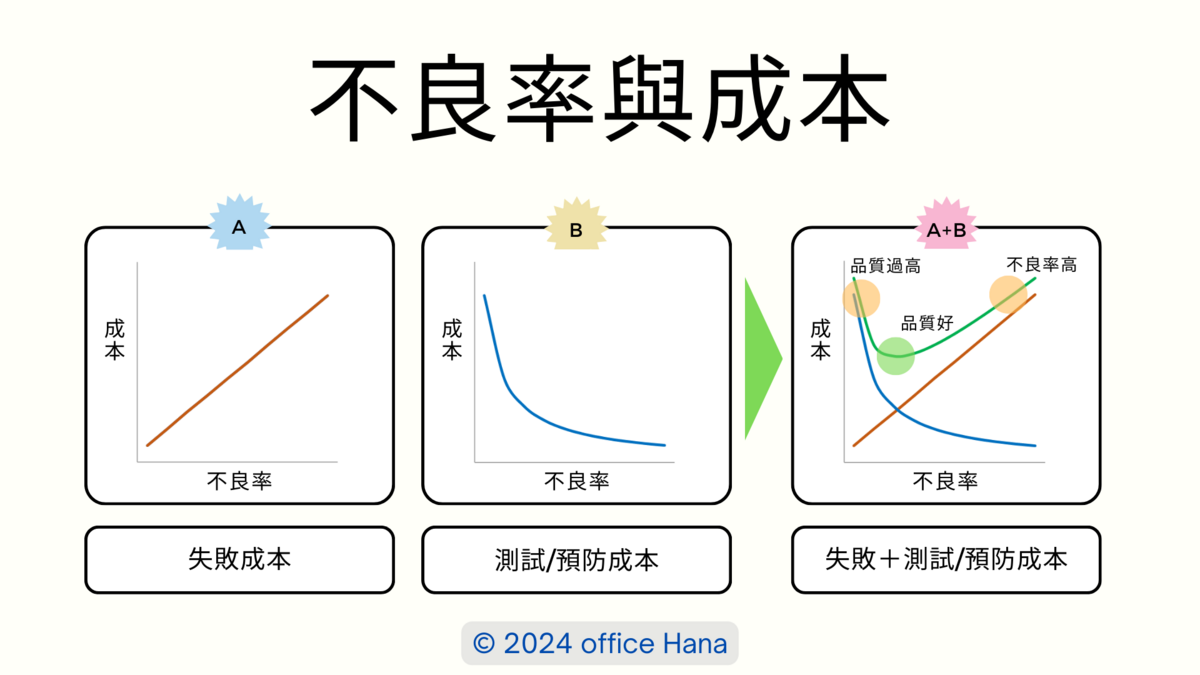Listed in English, Formosan, and Japanese in that order.
Please note that this is an automatic translation.
按順序列出了英語、台灣語和日語。
請注意,這是自動翻譯。
日本語は最後にあります。

What Does High Quality Mean?
One of the biggest challenges faced by small and medium-sized business owners is balancing quality and cost. If the quality is too high, costs can become prohibitive. Conversely, if the quality is too low, you risk losing customer trust. So, what can be achieved with proper quality management?
The bottom line is that by changing the way we think about quality, small and medium-sized business owners can achieve both cost reduction and improved efficiency. Operating at an appropriate quality level is essential for long-term business success.
Three Key Points:
1. The Relationship Between Defect Rates and Costs:
The higher the defect rate, the more costs increase due to returns and rework. However, excessively pursuing high quality can lead to unnecessary inspection and prevention costs. The optimal point is where the total cost of failures and the cost of inspection and prevention are minimized.
2. Rethinking the Definition of Quality:
Defining quality as “the inherent characteristics that meet the intended use,” as per standards like JIS, means that quality encompasses not just the functionality of the product but the overall customer satisfaction it brings. From this perspective, improving quality is directly linked to minimizing customer losses.
3. The Relationship Between Quality Improvement and Cost Reduction:
Good quality means more than just the product functioning properly. High-quality products build long-term customer trust and, as a result, help avoid unnecessary costs, leading to overall cost savings.
Quality management is a crucial factor for small and medium-sized businesses to reduce costs and enhance competitiveness. With proper quality management, businesses can maintain defect rates at optimal levels, increase productivity, and ensure customer satisfaction. Finding this balance is key to a sustainable business model.
高品質的意義是什麼?
中小企業主面臨的最大挑戰之一是如何平衡品質與成本。如果品質過高,成本可能會變得難以承擔。相反地,如果品質過低,則可能會失去顧客的信任。那么,通過適當的品質管理可以達成什麼目標呢?
總的來說,改變我們對品質的看法可以讓中小企業主同時實現成本降低和效率提升。以適當的品質水準運營對於長期的商業成功至關重要。
三個關鍵點:
1. 缺陷率與成本的關係:
缺陷率越高,退貨和返工的成本就越高。然而,過度追求高品質會導致不必要的檢查和預防成本。最佳點是失敗成本和檢查預防成本的總和最小的點。
2. 重新思考品質的定義:
根據如JIS等標準,將品質定義為“符合使用目的的固有特性”,這意味著品質不僅僅是產品的功能,而是它帶來的整體顧客滿意度。從這個角度看,改善品質直接與最小化顧客損失相關。
3. 品質改進與成本降低的關係:
良好的品質不僅意味著產品正常運作。高品質的產品能建立長期的顧客信任,從而避免不必要的成本,最終達到整體成本的節省。
品質管理是中小企業降低成本和提升競爭力的關鍵因素。通過適當的品質管理,企業可以將缺陷率保持在最佳水準,提高生產力,並確保顧客滿意度。找到這個平衡點是實現可持續商業模式的關鍵。
高品質とは何か?
中小企業経営者が直面する最大の課題の一つが、品質とコストのバランスをどう取るかです。品質が高すぎるとコストがかさみ、逆に品質が低すぎると顧客の信頼を失う可能性があります。では、適切な品質管理で得られるものとは何でしょうか?
結論から言うと、品質の考え方を変えることで、中小企業経営者はコスト削減と効率向上の両方を実現できると結論づけられます。適切な品質レベルで運営を行うことが、長期的なビジネスの成功には不可欠です。
ポイントは3つ
1. 不良率とコストの関係:
不良率が高ければ高いほど、返品や再生産のコストが増えます。しかし、あまりに品質を追求しすぎると、過剰な検査や予防コストがかさみます。最適な点は、失敗のコストと検査・予防のコストの合計が最小になる点です。
2. 品質の定義の再考:
JISのように品質を「使用目的を満たす固有の性質」と定義すると、品質は単なる製品の機能だけでなく、それがもたらす総合的な顧客満足を意味します。この観点から、品質改善は顧客の損失を最小化することに直結します。
3. 品質改善とコストダウンの関係:
品質が良いとは、単に製品が正常に機能すること以上の意味を持ちます。品質の高い製品は、長期的に見て顧客からの信頼を獲得し、結果として余計なコストをかけずに済むため、全体のコスト削減につながります。
品質管理は中小企業にとってコストを削減し、競争力を高めるための重要な要素です。適切な品質管理によって、不良率を最適なレベルに保ちながら、生産性を高め、顧客満足を確保することができます。このバランスを見つけ出すことが、持続可能なビジネスモデルへの鍵となるでしょう。
office Hana An / 小庵
Quality Consultant / 品質顧問 / 品質コンサルタント
I have been involved in hardware design for electrical products for 20 years and have provided quality control guidance for electrical components for 10 years.
Through quality control guidance, manufacturing process audits, and support in problem-solving, I lead clients' businesses to growth.
我從事電子產品硬體設計已有 20 年,並且擔任電氣元件品質控制指導已有 10 年。
透過品質控制指導、製造流程審核和問題解決支援等方式,我引導客戶的業務成長。
私は電気製品のハードウェア設計を20年、電気部品の品質管理指導を10年行ってきました。
品質管理の指導、製造工程の監査、問題解決のサポートなどによりクライアントのビジネスを成長に導きます。